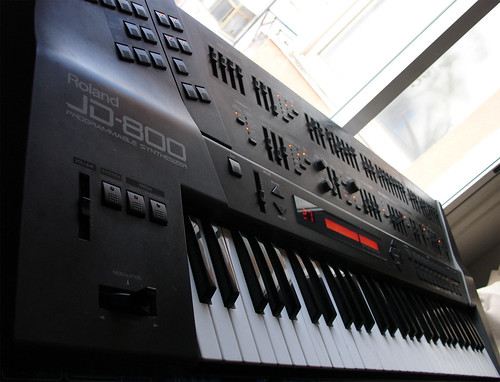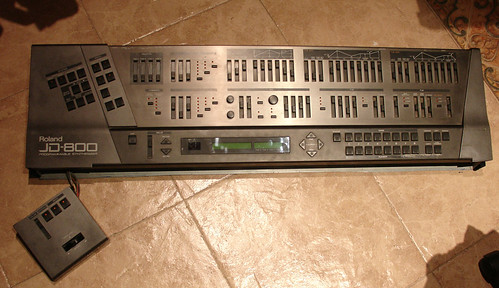In the Harmony Central site, the
Keys, Synths & Samples forum is the one of the best group about synths and synth players I have found.
From there is this great post about one of the famous problems of the JD-800: the
sticky key, also know as the
Red glue problem. .
Link to the original topic:
***Flats-JD800-Sticky-Key-Session-***
Topics created by
Flat Earth - Vive La Synthesizer! You find him at www.gearslutz.com
***Flats JD800 Sticky Key Session ***
Heres a very quick guide to sorting out the infamous Roland JD800 'Sticky key problem'
As you are only allowed 10 images, I´m sorry if it is not too clear.
Remove the 8 screws located under the ‘ROLAND’ logo on the back of the
JD800. then the 2 screws on the underside of the JD and the 3 screws at
either ends (left image). The top facia of the synth will open up like a
bonnet revealing the circuitry and keyboard (a strap on the left hand
side prevents the lid/facia from falling back)
The keyboard can now be removed. Firstly, gently prize out the ribbon
connector that connects the keyboard to the motherboard (left image).
Using a side-to-side motion (don’t force it!), then unscrew the 6 gold
screws running along the top of the keyboard chassis (right image), and
the 5 screws underneath the synth (holding the keyboard steady)
The whole keyboard assembly should slide forward easily now. Before
taking apart the keyboard, its best to lay it face down on a towel or
soft cloth (keep a dish handy for small parts)
On the back of the metal keyboard chassis, there are 5 black strips
securing each octave of the keys. Remove 1 strip and the one octave of
keys at a time. A knife or flat screwdriver can be inserted under the
strip to gently prise it off. (See above right)
After the strip has been removed, each key can be taken out by gently
pushing it out. (After each key has been removed, take out each
corresponding metal spring clip that is underneath the key, and put it
somewhere safe. Put all the keys in order, upside down on a piece of
board. (Right image)
At this point, you should be able to see the ‘Red glue’ that is causing
the
sticky key (red glue) problem.
I found in my case, all the problems seem to
emanate from the glue leaking from the ‘black keys’. The glue had
dripped down onto the damping strip & between the keys themselves.
(see below)
The ‘Red glue’ can be cleaned easily from between the keys. The glue
that has fouled the damping strip on the other hand (left image), has to
be gently scraped off with a scalpel. I found some of the glue had been
absorbed by the damping strip. I was able to cut it out, and then
‘fluff up’ the resulting hole. If the damping strip were too heavily
saturated with glue, it would be a better idea to replace it (if Roland
can still supply this).
Once all the glue has been cleaned away, it’s worth cleaning the
contacts. Just remove the 5 grey rubber contact suspension mats and
clean the whole strip with a light tissue doused in cleaning fluid. (Be
careful removing these mats, as the small rubber securing cones can tear
easily!)
The keyboard section can now be re-assembled and tested.
I found that putting a thin layer of hot glue over the ‘red glue’ in the
black keys could prevent further leakage in the future. But not too
much as to make the key too heavy.
Hope this is of use to anybody experiencing similar problems.
.'.
Additional comments from that topic and very useful info from the topic follow. (Edited)
Comment by Don Solaris -
Certified Synth Maniac
Unfortunately, cleaning of damping strip from bottom side is not that
easy. And the only solution (after you clear keys and before you put
them back) is to take a small piece of Post-It paper and put it right
over the glue. Glue will hold it, and key won't be sticky anymore.
Same can be applied to top side of damping strip as in many cases, the
glue already penetrated it deep enough, that you can no longer cut it
out with scalpel.
Comment by
MarkShovel2
I found it was essential to get the metal spring clips uniformally
seated on each key. I had a few black keys that were stiff. I observed
that the metal clips were not correctly seated into the top of the key.
When correctly seated, everything is very uniform. The action now
approaches my two V-Synths.
Comment by
Flat Earth
Id thought of putting a small piece of thin plastic or paper over the
saturated parts of the damping strip, but after gently cutting it out, i
was able to 'fluff' it up, with a needle back to a pretty good state.
Comment by
4thtry
As in your case the black keys were causing the majority of the problem.
I used a tube of silicon instead of hot glue to try and seal in the
offending red glue. I had to be careful not to add too much or the
little metal stopper with the rubber jacket would come in contact and
add unwanted friction.
Comment by
Flat Earth
when i inserted the hot glue, i had to be careful not to put too much
in. I found a small blob either side of the weight did the trick. Used a
small screw driver to spread it over the red glue, but you have to be
quick, the hot glue sets quite quickly.
I didnt do the white keys btw. Even if they had 'leaked', they wouldnt
cause any problems with the keybed mech as they arnt above it. I will be
keeping an eye on them though.
Comment by
Flat Earth
Update
After repairing the keyboard action (which now plays super smooth) i
found I had a few dead notes. I thought the culprit may well be the
rubber dome key contacts, so i took it apart again and made a note of
which keys failed to play. I then swapped one of the 5 grey strips with
another and checked to see if the key played. **BINGO** they worked.
They rubber strip must have worn out. Its best to replace all 5, but
remember, the 5th strip (top octave) is different to the lower 4 octave
strips. It has 13 contacts rather then 12 like on the other lower
octaves. Take this into account when ordering replacements.
.'.
Another topic for the Red Glue problem is:
One fix for red glue problem.

















































